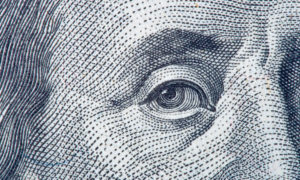
Photo credit: Getty Images
The first of a three-part series on how best to pay off your student loans.
Evon Mendrin, CFP,® CSLP®
Dec. 20, 2023
Federal student loans are on the minds and balance sheets of just about every optometrist. They fund your education and allow you to enter the profession.
Yet, with increasing debt levels, what is the best approach to tackling debt – especially in light of other goals, like getting into practice ownership or reinvesting into your practice?
The ideal approach should have a likely lower cost over time (measured appropriately), allow you to prepare for any shorter-term financial or career goals that are higher priorities and align with your overall values around debt.
There are three main approaches to managing your federal student loans, each appropriate for different circumstances:
- Paying down your debt to $0
- Aiming for forgiveness using income-driven repayment (IDR) plans
- A blended approach using IDR plans strategically
This first article in the series will look at your options for paying student debt down to $0.
Paying Your Student Loans Down to $0
This approach is ideal if:
- Your federal student loan balances are relatively close to your annual income (after pre-tax deductions like 401k contributions). A general guideline is if your federal loan balance is less than 1.5x your current or expected income.
- You have strong, consistent cash flow, can build a healthy emergency savings and have no major uncertainty in your career coming up (like practice ownership).
- You have a strong feeling toward paying debt aggressively or against holding debt in general.
Your student loans are treated like any other – it’s traditional debt planning. Your goal is to pay down the debt as quickly as reasonably possible and limit the total amount of interest paid.
The default starting point is usually the standard 10-year repayment plan, or a longer repayment schedule if you’ve consolidated your loans.
There are two levers to pull to help lower the cost – the amount you pay to the principal and the interest rate of the debt. With that in mind, here are a few tips and tricks to keep in mind when tackling your student loans.
Debt Avalanche – Tackling the Highest Interest Rates First
The simplest way to tackle debt faster is to pay more into the debt. Based purely on the math, you’d want to pay extra first into the loans with highest interest rates.
Unless you’ve consolidated your loans, you should have a list of different federal loans taken out over the years, with different balances and interest rates.
Other Articles to Explore
Using the debt avalanche method, you’d pay the minimum amounts into all loans and apply extra payments to the highest interest rate debt. Once each debt is paid off, you take that loan’s total monthly payment and pay it into the next highest loan. The result should be a lower total interest cost over the life of the loans.
You can apply this method beyond your student loans. View your student loans as a part of all of the debts in your household. You likely have auto loans, practice debts, personal loans or home equity lines.
Apply the avalanche method to your whole household, paying the minimum amount toward all loans and tackling the highest interest rates most aggressively.
Refinancing With Private Lenders
If you’re certain you’ll pay your debts down to $0, then private refinancing is a tool to consider. That is, refinancing out of the federal student loan system with a private lender. The primary goal is to lower your interest rate enough to make a difference and the total cost of the loans.
However, use caution with refinancing, especially while current interest rates are high. Once you leave the federal loan system, you can’t go back in. You lose the protections, flexibility and potential favorable changes of the federal loan system.
You do not need to refinance your loans to pay them down. You can simply use the payment plans available in the federal system.
If you’re sure this is the route you’d like to take, there’s a materially lower interest rate with the private lender, you have stable cash flow, have built an emergency fund, and have basic insurance coverages, then it can be a great way to lower the total cost of your debt.
Consider Refinance Ladders
You may want to consider refinance ladders – refinancing first to a longer term, such as 15 or 20 years. You’d have a lower required minimum payment, but would still pay the higher monthly amount.
As you pay down the principal, you can continue to refinance again (and again) to shorter-term loans, picking up hopefully lower interest rates and potential upfront bonuses along the way.
You’ll likely see a higher interest rate with a longer-term refinance. However, this helps maintain as much cash flow flexibility as possible with lower required payments, while still paying the debt down aggressively.
Also review the private lender’s promissory note for loan terms. How will it handle the loans at your death or disability? Are there opportunities for forbearance? How are co-signers handled?
Use the SAVE Repayment Plan for a Debt Avalanche (Or Building Your Savings)
Since the current high interest rates leave limited slam-dunk refinance opportunities, the SAVE income-driven repayment plan provides an interesting opportunity.
Income-driven plans base monthly payments only on your income and family size. The debt size and interest rates don’t factor in at all.
The recently announced SAVE plan may allow you to lower your required minimum payment. Using the avalanche method, you can pay the same higher monthly amount as your standard repayment, but pay the extra dollars into the highest interest rate loans first.
What’s great about the SAVE plan is that there is no accruing unpaid interest. If your calculated payments are lower than the interest charged on your debt, the unpaid interest doesn’t accrue. It’s waived.
With that in mind, you might decide to instead put the extra dollars into a high-yield savings account, money market fund, or short-term U.S. Treasury bill to earn an attractive interest rate. You might then take the savings and pay a large lump-sum down the road.
Keep The Bigger Picture in Mind
Lastly, keep in mind the opportunity costs of paying extra dollars aggressively into the debt. For example, are you waiting to start investing and building assets? Delaying private practice ownership? Do the tradeoffs you see make sense?
Keep your other financial needs, family goals and upcoming career goals in mind when making student loan decisions. After all, they’re just a piece of the overall puzzle.
 Evon Mendrin, CFP®, CSLP® is the founder of Optometry Wealth Advisors. To contact him: evon@optometrywealth.com
Evon Mendrin, CFP®, CSLP® is the founder of Optometry Wealth Advisors. To contact him: evon@optometrywealth.com



























